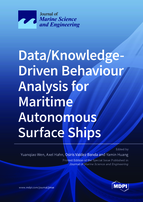Data/Knowledge-Driven Behaviour Analysis for Maritime Autonomous Surface Ships
A special issue of Journal of Marine Science and Engineering (ISSN 2077-1312). This special issue belongs to the section "Ocean Engineering".
Deadline for manuscript submissions: closed (15 June 2022) | Viewed by 29179
Special Issue Editors
Interests: nautical traffic safety and simulation; artificial intelligence and its applications in maritime; maritime autonomous surface ships
Special Issues, Collections and Topics in MDPI journals
Interests: simulation; maritime systems; transportation; navigation
Special Issues, Collections and Topics in MDPI journals
Interests: safety and systems engineering; risk analysis; maritime safety; winter navigation; autonomous ships
Special Issues, Collections and Topics in MDPI journals
Interests: human–machine cooperation; autonomous ships; ship collision avoidance; maritime traffic management
Special Issues, Collections and Topics in MDPI journals
Special Issue Information
Dear Colleagues,
Understanding, modeling, and predicting ship behavior are fundamental and essential issues for planning, controlling, and operating different levels of maritime autonomous surface ships (MASS). The maritime traffic data (e.g., radar data, AIS data, CCTV data) provide designers, officers on watch, and traffic operators with extensive information about the states of ships at present and in history, which are a treasure for behavior analysis. Additionally, navigation rules and regulations (i.e., knowledge) offer valuable prior knowledge about ship manners at sea. Combining multisource heterogeneous big data and artificial intelligence techniques inspire innovative and important means for the development of MASS, leading to smart, safe, green, and efficient shipping. Thus, this Special Issue aims to provide a medium to present the latest developments on methods and tools suitable for relevant issues, including but not limited to:
- Data-driven behavior modeling and simulation;
- Knowledge-driven behavior modeling and reasoning;
- Multisource heterogeneous traffic data fusion;
- Semantic analysis of ship behaviors;
- Quantifying COLREGs and seamanship for machine;
- Inference engine and ontology reasoning for rule-compliant MASS;
- Intention inference based on behavior observations;
- Maritime traffic situational awareness;
- Multiagent simulation;
- Risk analysis and management of MASS;
- Safety and cybersecurity of MASS.
Prof. Dr. Yuanqiao Wen
Prof. Dr. Axel Hahn
Prof. Dr. Osiris Valdez Banda
Prof. Dr. Yamin Huang
Guest Editors
Manuscript Submission Information
Manuscripts should be submitted online at www.mdpi.com by registering and logging in to this website. Once you are registered, click here to go to the submission form. Manuscripts can be submitted until the deadline. All submissions that pass pre-check are peer-reviewed. Accepted papers will be published continuously in the journal (as soon as accepted) and will be listed together on the special issue website. Research articles, review articles as well as short communications are invited. For planned papers, a title and short abstract (about 100 words) can be sent to the Editorial Office for announcement on this website.
Submitted manuscripts should not have been published previously, nor be under consideration for publication elsewhere (except conference proceedings papers). All manuscripts are thoroughly refereed through a single-blind peer-review process. A guide for authors and other relevant information for submission of manuscripts is available on the Instructions for Authors page. Journal of Marine Science and Engineering is an international peer-reviewed open access monthly journal published by MDPI.
Please visit the Instructions for Authors page before submitting a manuscript. The Article Processing Charge (APC) for publication in this open access journal is 2600 CHF (Swiss Francs). Submitted papers should be well formatted and use good English. Authors may use MDPI's English editing service prior to publication or during author revisions.
Keywords
- Maritime Autonomous Surface Ships (MASS)
- Data-driven modeling
- Knowledge-driven modeling
- Behavior modeling
- Knowledge graph
- Navigation simulation
- Multisource heterogeneous data analysis
- Nautical safety
- Quantifying rules and regulations









